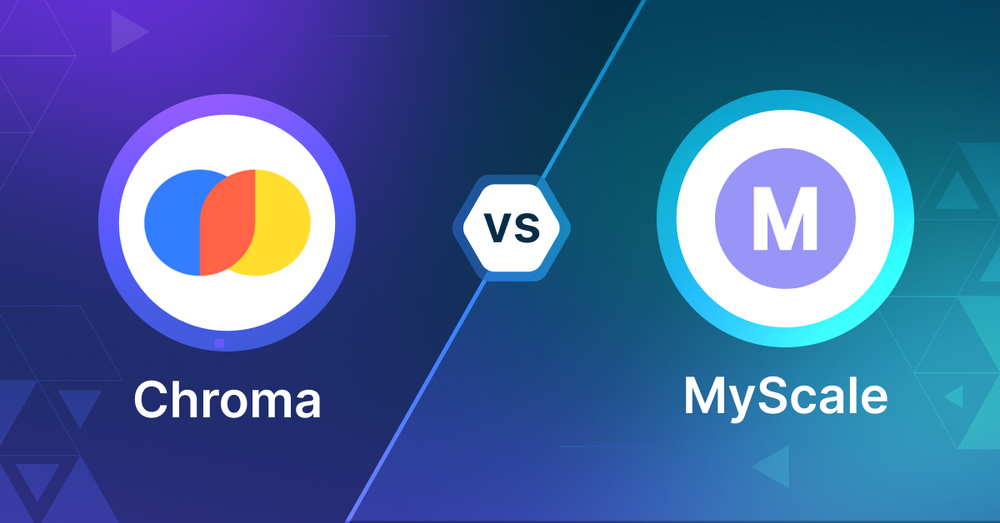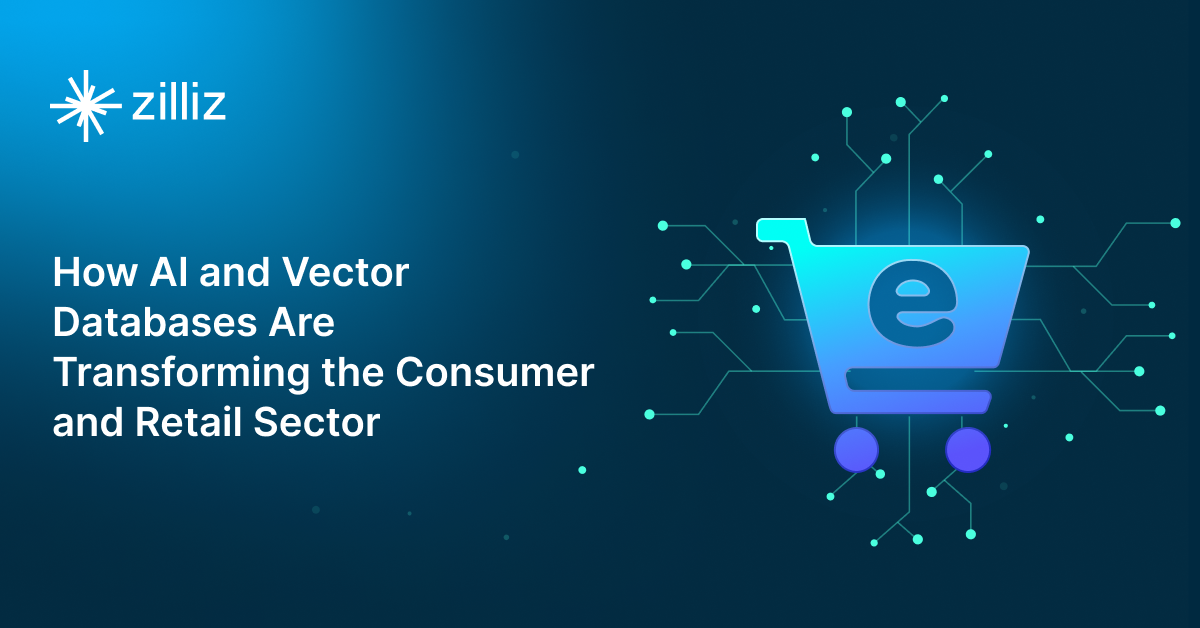Chroma vs MyScale on Vector Search Capabilities

As AI-driven applications become more prevalent, developers and engineers face the challenge of selecting the right database to handle vector data efficiently. Two popular options in this space are Chroma and MyScale. This article compares these technologies to help you make an informed decision for your vector database needs.
What is a Vector Database?
Before we compare Chroma and MyScale, let's first explore the concept of vector databases. A vector database is specifically designed to store and query high-dimensional vectors, which are numerical representations of unstructured data. These vectors encode complex information, such as text's semantic meaning, images' visual features, or product attributes. By enabling efficient similarity searches, vector databases play a pivotal role in AI applications, allowing for more advanced data analysis and retrieval.
Vector databases are adopted in many use cases, including e-commerce product recommendations, content discovery platforms, anomaly detection in cybersecurity, medical image analysis, and natural language processing (NLP) tasks. They also play a crucial role in Retrieval Augmented Generation (RAG), a technique that enhances the performance of large language models (LLMs) by providing external knowledge to reduce issues like AI hallucinations.
There are many types of vector databases available in the market, including:
Purpose-built vector databases such as Milvus, Zilliz Cloud (fully managed Milvus)
Lightweight vector databases such as Chroma and Milvus Lite.
Traditional databases with vector search add-ons capable of performing small-scale vector searches.
Chroma and Myscale represent different approaches to vector databases. Cassandra is a traditional database that has evolved to include vector search capabilities and Vald, on the other hand, is a purpose-built vector database. It was designed from the ground up to handle vector data and perform similarity searches efficiently. As a specialized solution, Vald focuses exclusively on vector operations and is optimized for tasks like similarity search and recommendations.
What is Chroma? An Overview
Chroma is an open-source, AI-native vector database that simplifies the process of building AI applications. It acts as a bridge between large language models (LLMs) and the data they require to function effectively. Chroma's main objective is to make knowledge, facts, and skills easily accessible to LLMs, thereby streamlining the development of AI-powered applications. At its core, Chroma provides tools for managing vector data, allowing developers to store embeddings (vector representations of data) along with their associated metadata. This capability is crucial for many AI applications, as it enables efficient similarity searches and data retrieval based on vector relationships.
One of Chroma's key strengths is its focus on simplicity and developer productivity. The team behind Chroma has prioritized creating an intuitive interface that allows developers to quickly integrate vector search capabilities into their applications. This emphasis on ease of use doesn't come at the cost of performance. Chroma is designed to be fast and efficient, making it suitable for a wide range of applications. It operates as a server and offers first-party client SDKs for both Python and JavaScript/TypeScript, providing flexibility for developers to work in their preferred programming environment.
Chroma's functionality revolves around the concept of collections, which are groups of related embeddings. When adding documents to a Chroma collection, the system can automatically tokenize and embed them using a specified embedding function, or a default one if not provided. This process transforms raw data into vector representations that can be efficiently searched. Along with the embeddings, Chroma allows storage of metadata for each document, which can include additional information useful for filtering or organizing data. Chroma provides flexible querying options, allowing searches for similar documents using either vector embeddings or text queries, returning the closest matches based on vector similarity.
Chroma stands out in several ways. Its API is designed to be intuitive and easy to use, reducing the learning curve for developers new to vector databases. It supports various types of data and can work with different embedding models, allowing users to choose the best approach for their specific use case. Chroma is built to integrate seamlessly with other AI tools and frameworks, making it a good fit for complex AI pipelines. Additionally, Chroma's open-source nature (licensed under Apache 2.0) provides transparency and the potential for community-driven improvements and customizations. The Chroma team is actively working on enhancements, including plans for a managed service (Hosted Chroma) and various tooling improvements, indicating a commitment to ongoing development and support.
What is MyScale? An Overview
MyScale is a cloud-based database solution built on the open-source ClickHouse database, designed specifically for AI and machine learning workloads. It can handle both structured and vector data, supporting real-time analytics and machine learning tasks. MyScale focuses on time-series data, vector search, and full-text search, making it suitable for applications requiring real-time processing and AI-driven insights. By leveraging ClickHouse's architecture, MyScale offers high performance and scalability for AI applications.
One of MyScale's key features is its native SQL support, which simplifies complex AI-driven queries by integrating vector search, full-text search, and traditional SQL queries in a unified system. This approach reduces the need for multiple tools and ensures scalability for AI applications. MyScale supports and manages the analytical processing of both structured and vectorized data on a single platform, utilizing advanced OLAP database architecture to execute operations on vectorized data efficiently. Developers can interact with MyScale using SQL, making it accessible to a wide range of programmers familiar with relational databases.
MyScale offers various vector index types and similarity metrics to cater to different use cases. It supports common distance metrics like Euclidean distance (L2), inner product (IP), and cosine similarity. The database provides several indexing algorithms, including MSTG (Multi-Scale Tree Graph), ScaNN, IVFFLAT, IVFPQ, IVFSQ, and HNSW, each with its own set of parameters for performance tuning. MyScale's proprietary MSTG vector engine leverages NVMe SSDs to enhance data density, allowing it to outperform specialized vector databases in both performance and cost-efficiency.
By integrating the functionalities of an SQL database, vector database, and full-text search engine into a single system, MyScale aims to reduce infrastructure and maintenance costs. This unification facilitates joint data queries and analytics, establishing a versatile data foundation for AI applications. MyScale also offers comprehensive observability for LLM systems through MyScale Telemetry, ensuring efficient monitoring and debugging. As data complexity grows, MyScale positions itself as a future-proof solution capable of handling newer data modalities and database sizes while maintaining computing performance and integration between different data types.
Key Differences
Search Methodology
Chroma and MyScale both offer vector search capabilities, but their approaches differ. Chroma provides flexible querying options, allowing searches using either vector embeddings or text queries. It returns the closest matches based on vector similarity. MyScale, on the other hand, offers a wider range of vector index types and similarity metrics. It supports common distance metrics like Euclidean distance (L2), inner product (IP), and cosine similarity, and provides several indexing algorithms including MSTG, ScaNN, IVFFLAT, IVFPQ, IVFSQ, and HNSW. This variety allows MyScale to cater to a broader range of use cases and potentially offer more fine-tuned search performance.
Data Handling
Chroma focuses primarily on managing vector data and associated metadata. It allows developers to store embeddings along with their metadata, enabling efficient similarity searches and data retrieval based on vector relationships. MyScale, built on ClickHouse, handles both structured and vector data. It supports real-time analytics on time-series data, vector search, and full-text search. This makes MyScale potentially more versatile for applications that need to work with various data types beyond just vector data.
Scalability and Performance
Chroma is designed to be fast and efficient, suitable for a wide range of applications. However, specific details about its scalability for very large datasets are not provided in the overview. MyScale, leveraging ClickHouse's architecture, offers high performance and scalability for AI applications. It uses advanced OLAP database architecture to execute operations on vectorized data efficiently. MyScale's proprietary MSTG vector engine, which leverages NVMe SSDs, claims to enhance data density and outperform specialized vector databases in both performance and cost-efficiency.
Flexibility and Customization
Chroma offers flexibility in terms of supporting various types of data and different embedding models. Users can choose the best approach for their specific use case. MyScale provides flexibility through its SQL interface, allowing complex queries that combine vector search, full-text search, and traditional SQL queries. It also offers various indexing algorithms and parameters for performance tuning, potentially providing more options for customization.
Integration and Ecosystem
Chroma is built to work seamlessly with other AI tools and frameworks, making it suitable for complex AI pipelines. It provides first-party client SDKs for both Python and JavaScript/TypeScript. MyScale, being built on ClickHouse, can take advantage of ClickHouse's mature codebase and ecosystem. It integrates the functionalities of an SQL database, vector database, and full-text search engine into a single system, which could simplify the overall architecture of AI applications.
Ease of Use
Chroma emphasizes simplicity and developer productivity, with an intuitive interface that allows quick integration of vector search capabilities. Its API is designed to be easy to use, potentially reducing the learning curve for developers new to vector databases. MyScale, while offering powerful features, might have a steeper learning curve due to its broader range of functionalities. However, its use of SQL as the primary interface could make it more accessible to developers already familiar with relational databases.
Cost Considerations
The overview doesn't provide specific information about Chroma's cost structure. For MyScale, while exact pricing isn't mentioned, it's positioned as a cost-effective solution. By integrating multiple functionalities (SQL database, vector database, full-text search) into a single system, MyScale aims to reduce infrastructure and maintenance costs compared to using multiple specialized tools.
Security Features
Neither overview provides detailed information about security features. This would be an area where more information is needed to make a comprehensive comparison. However, given MyScale's positioning as an enterprise-ready solution, it likely offers standard database security features. Chroma, being open-source, might rely more on community-driven security improvements.
When to Choose Chroma or MyScale
Chroma is an excellent choice for projects that require quick setup and integration of vector search capabilities, especially in AI-driven applications. It's particularly suitable for teams looking for an open-source solution that they can potentially customize or contribute to. Chroma shines in applications that primarily work with vector data and don't require complex SQL operations or handling of diverse data types. Developers who prefer working with Python or JavaScript/TypeScript will appreciate Chroma's native SDK support. It's ideal for scenarios where seamless integration with other AI tools and frameworks is a priority. Teams that value simplicity and ease of use over a wide range of advanced features will find Chroma to be a good fit.
On the other hand, MyScale is the better option for projects that require handling both structured and vector data, especially those involving time-series data, vector search, and full-text search. It's well-suited for applications that need to perform complex queries combining vector search with traditional SQL operations. Teams that are already familiar with SQL and want to leverage this knowledge in working with vector data will find MyScale appealing. It's a strong choice in scenarios where high performance and scalability for large datasets are crucial. MyScale is ideal for projects that require a unified solution for SQL database, vector database, and full-text search functionalities. It offers fine-grained control over vector indexing and search algorithms, making it suitable for teams that need this level of customization.
MyScale is particularly well-suited for enterprise-level applications that require comprehensive observability and monitoring capabilities. Its architecture, built on ClickHouse, provides advantages in terms of performance and scalability, which can be crucial for handling large-scale AI workloads. Organizations looking for cost-efficiency in managing complex data operations might find MyScale's integrated approach more economical than using multiple specialized tools.
Ultimately, the choice between Chroma and MyScale depends on the specific requirements of your project. Chroma offers simplicity and ease of integration, making it a good choice for projects where vector search is the primary focus and rapid development is key. MyScale, with its broader feature set and SQL compatibility, is more suitable for complex, data-intensive applications that require handling various data types and advanced querying capabilities. Consider your team's expertise, the scale of your data, the complexity of your queries, and your long-term scalability needs when making your decision.
Conclusion
When it comes to vector databases, Chroma and MyScale each offer distinct advantages. Chroma is notable for its simplicity, ease of use, and focus on AI-driven applications, making it a good fit for teams that need quick integration and straightforward vector search capabilities. MyScale, built on ClickHouse, provides a more comprehensive solution that combines vector search with traditional SQL operations and handles various data types. It's well-suited for complex, data-intensive applications that require scalability and advanced querying. Your choice between these two technologies will depend on your project's specific needs, including the complexity of your data operations, the size of your datasets, your team's expertise, and your long-term scalability requirements. Both Chroma and MyScale offer valuable tools for implementing vector search in modern AI and data-driven applications, each catering to different use cases and preferences.
When to Choose a Specialized Vector Database?
While Chroma and Myscale offer vector search capabilities, they are not optimized for large-scale, high-performance vector search tasks. If your application relies on fast, accurate similarity searches over millions or billions of high-dimensional vectors, such as in image recognition, e-commerce recommendations, or NLP tasks, specialized vector databases like like Milvus and Zilliz Cloud (the managed Milvus) are a better fit. These databases are built to handle vector data at scale, using advanced Approximate Nearest Neighbor (ANN) algorithms (e.g., HNSW, IVF ) and offering advanced features like hybrid search (including hybrid sparse and dense search, multimodal search, vector search with metadata filtering, and hybrid dense and full-text search), real-time ingestion, and distributed scalability for high-performance in dynamic environments.
On the other hand, general-purpose systems like Chroma or Myscale are suitable when vector search is not the primary focus, and you’re handling structured or semi-structured data with smaller vector datasets or moderate performance requirements. If you already use these systems and want to avoid the overhead of introducing new infrastructure, vector search plugins can extend their capabilities and provide a cost-effective solution for simpler, lower-scale vector search tasks.
Using Open-source VectorDBBench to Evaluate and Compare Vector Databases on Your Own
VectorDBBench is an open-source benchmarking tool designed for users who require high-performance data storage and retrieval systems, particularly vector databases. This tool allows users to test and compare the performance of different vector database systems such as Milvus and Zilliz Cloud (the managed Milvus) using their own datasets and determine the most suitable one for their use cases. Using VectorDBBench, users can make informed decisions based on the actual vector database performance rather than relying on marketing claims or anecdotal evidence.
VectorDBBench is written in Python and licensed under the MIT open-source license, meaning anyone can freely use, modify, and distribute it. The tool is actively maintained by a community of developers committed to improving its features and performance.
Download VectorDBBench from its GitHub repository to reproduce our benchmark results or obtain performance results on your own datasets.
Take a quick look at the performance of mainstream vector databases on the VectorDBBench Leaderboard.
Read the following blogs to learn more about vector database evaluation.
Further Resources about VectorDB, GenAI, and ML
- What is a Vector Database?
- What is Chroma? An Overview
- What is MyScale? An Overview
- Key Differences
- When to Choose Chroma or MyScale
- Conclusion
- When to Choose a Specialized Vector Database?
- Using Open-source VectorDBBench to Evaluate and Compare Vector Databases on Your Own
- Further Resources about VectorDB, GenAI, and ML
Content
Start Free, Scale Easily
Try the fully-managed vector database built for your GenAI applications.
Try Zilliz Cloud for FreeKeep Reading

Zilliz Cloud Now Available in Azure North Europe: Bringing AI-Powered Vector Search Closer to European Customers
The addition of the Azure North Europe (Ireland) region further expands our global footprint to better serve our European customers.

Why DeepSeek V3 is Taking the AI World by Storm: A Developer’s Perspective
Explore how DeepSeek V3 achieves GPT-4 level performance at fraction of the cost. Learn about MLA, MoE, and MTP innovations driving this open-source breakthrough.

How AI and Vector Databases Are Transforming the Consumer and Retail Sector
AI and vector databases are transforming retail, enhancing personalization, search, customer service, and operations. Discover how Zilliz Cloud helps drive growth and innovation.
The Definitive Guide to Choosing a Vector Database
Overwhelmed by all the options? Learn key features to look for & how to evaluate with your own data. Choose with confidence.